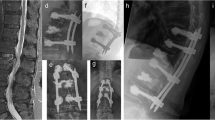Abstract
Background
The three-point orthosis is the most commonly used brace in the conservative treatment of osteoporotic vertebral fractures. The Spinomed® dynamic orthosis represents an alternative.
Aims
We compared efficacy and safety of these two types of brace in treating osteoporotic vertebral fractures.
Methods
One hundred forty patients, aged 65–93 years, sustaining osteoporotic vertebral fracture were consecutively recruited and divided into two groups, and treated with either three-point orthosis or dynamic corset. Patients were evaluated with Visual Analogue Scale, Oswestry Low Back Pain Disability Questionnaire, and measurement of forced expiratory volume in the first second. Regional kyphosis angle, Delmas Index, and height of the fractured vertebral body were also measured on full-spine X-rays. Follow-up intervals were 1, 3, and 6 months after trauma. The complications encountered during the 6-month follow-up were recorded.
Results
At the 3- and 6-month follow-ups, there was a significant difference (p < 0.05) in pain, disability, and respiration in favor of the dynamic orthosis group. At 6-month follow-up, there was no significant difference (p > 0.05) in all the radiological parameters between groups. Complications were reported for 28 patients in the three-point orthosis group, and for eight patients in the dynamic corset group (p < 0.05).
Discussion
Biofeedback activation of back muscles is probably a key factor in improving functional outcome with dynamic orthosis.
Conclusions
Compared to three-point orthosis, patients treated with dynamic orthosis had a greater reduction in pain and a greater improvement in quality of life and respiratory function, with equal effectiveness in stabilizing the fracture, and fewer complications.





Similar content being viewed by others
References
The European Prospective Osteoporosis Study Group (2002) Incidence of vertebral fracture in Europe: results from the European Prospective Osteoporosis Study (EPOS). J Bone Miner Res 17:716–724
Sinaki M (1998) Musculoskeletal challenges of osteoporosis. Aging (Milano) 10:249–262
Schlaich C, Minne HW, Bruckner T et al (1998) Reduced pulmonary function in patients with spinal osteoporotic fractures. Osteoporos Int 8:261–267
Begerow B, Pfeifer M, Pospeschill M et al (1999) Time since vertebral fracture: an important variable concerning quality of life in patients with postmenopausal osteoporosis. Osteoporos Int 10:26–33
Leidig-Bruckner G, Minne HW, Schlaich C et al (1997) Quality of life components and spinal deformity in women with chronic low back pain and women with vertebral osteoporosis. J Bone Miner Res 12:663–675
Lyles KW, Gold DT, Shipp KM et al (1993) Association of osteoporotic vertebral compression fractures with impaired functional status. Am J Med 94:595–601
Klezl Z, Bhangoo N, Phillips J et al (2012) Social implications of balloon kyphoplasty: prospective study from a single UK centre. Eur Spine J 21:1880–1886
Boonen S, Laan RF, Barton IP et al (2005) Effect of osteoporosis treatments on risk of non-vertebral fractures: review and meta-analysis of intention-to-treat studies. Osteoporos Int 16:1291–1298
Sinaki M, Khosla S, Limburg PJ et al (1993) Muscle strength in osteoporotic versus normal women. Osteoporos Int 3:8–12
Deyo RA, Tsui-Wu YJ (1987) Descriptive epidemiology of low-back pain and its related medical care in the United States. Spine 12:264–268
Kim HJ, Yi JM, Cho HG et al (2014) Comparative study of the treatment outcomes of osteoporotic compression fractures without neurologic injury using a rigid brace, a soft brace, and non brace. J Bone Joint Surg Am 96:1959–1966
Patwardhan AG, Li SP, Gavin T et al (1990) Orthotic stabilization of thoracolumbar injuries: a biomechanical analysis of the Jewett hyperextension orthosis. Spine 15:654–661
Genant HK, Wu CY, Van Kuijk C et al (1993) Vertebral fracture assessment using a semiquantitative technique. J Bone Miner Res 8:1137–1148
Mrozkowiak M, Dobriański J (2013) Algorithm for physiological spinal curvature within normative range. J Health Sci 3:102–134
Briggs AM, Wrigley TV, Tully EA et al (2007) Radiographic measures of thoracic kyphosis in osteoporosis: Cobb and vertebral centroid angles. Skelet Radiol 36:761–767
Murata K, Watanabe G, Kawaguchi S et al (2012) Union rates and prognostic variables of osteoporotic vertebral fractures treated with a rigid external support. J Neurosurg Spine 17:469–475
Pfeifer M, Begerow B, Minne HW (2004) Effects of a new spinal orthosis on posture, trunk strength, and quality of life in women with postmenopausal osteoporosis. Am J Phys Med Rehabil 63:177–186
Brown T, Norton PL (1957) The immobilization efficiency of back braces; their effect on the posture and motion of the lumbosacral spine. J Bone Joint Surg Am 39:111–139
Morris JM, Lucas DB (1964) Biomechanics of spinal bracing. Ariz Med 21:170–176
Nachemson A, Morris JM (1964) In vivo measurements of intradiscal pressure discometry, a method for the determination of pressure in the lower lumbar discs. J Bone Joint Surg Am 46:1077–1092
Lantz SA, Schultz AB (1986) Lumbar spine orthoses wearing. Effect on trunk muscle myoelectric activity. Spine 11:838–842
Leech JA, Dulberg C, Kellie S et al (1990) Relationship of lung function to severity of osteoporosis in women. Am Rev Respir Dis 141:66–71
Author information
Authors and Affiliations
Corresponding author
Ethics declarations
Conflict of interest
On behalf of all authors, the corresponding author states that there is no conflict of interest.
Human and animal rights
All procedures performed in this study were in accordance with the ethical standards of the institutional and/or national research committee and with the 1964 Helsinki Declaration and its later amendments or comparable ethical standards.
Informed consent
Informed consent was obtained from all individual participants included in the study.
Rights and permissions
About this article
Cite this article
Meccariello, L., Muzii, V.F., Falzarano, G. et al. Dynamic corset versus three-point brace in the treatment of osteoporotic compression fractures of the thoracic and lumbar spine: a prospective, comparative study. Aging Clin Exp Res 29, 443–449 (2017). https://doi.org/10.1007/s40520-016-0602-x
Received:
Accepted:
Published:
Issue Date:
DOI: https://doi.org/10.1007/s40520-016-0602-x




